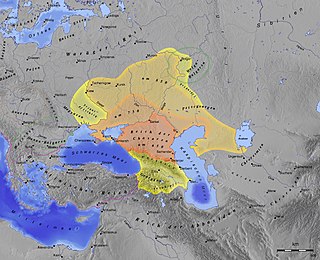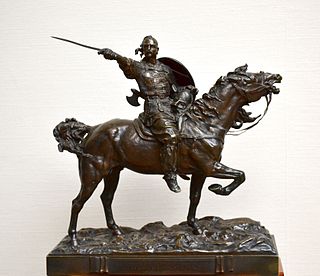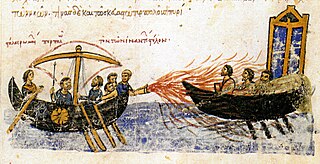
The Khazars were a nomadic Turkic people that, in the late 6th-century CE, established a major commercial empire covering the southeastern section of modern European Russia, southern Ukraine, Crimea, and Kazakhstan. They created what for its duration was the most powerful polity to emerge from the break-up of the Western Turkic Khaganate. Astride a major artery of commerce between Eastern Europe and Southwestern Asia, Khazaria became one of the foremost trading empires of the early medieval world, commanding the western marches of the Silk Road and playing a key commercial role as a crossroad between China, the Middle East and Kievan Rus'. For some three centuries the Khazars dominated the vast area extending from the Volga-Don steppes to the eastern Crimea and the northern Caucasus.

Sviatoslav or Svyatoslav I Igorevich was Prince of Kiev from 945 until his death in 972. He is known for his persistent campaigns in the east and south, which precipitated the collapse of two great powers in Eastern Europe, Khazaria and the First Bulgarian Empire. He conquered numerous East Slavic tribes, defeated the Alans and attacked the Volga Bulgars, and at times was allied with the Pechenegs and Magyars (Hungarians).
The Grand Prince of Kiev was the title of the monarch of Kievan Rus', residing in Kiev from the 10th to 13th centuries. In the 13th century, Kiev became an appanage principality first of the grand prince of Vladimir and the Mongol Golden Horde governors, and later was taken over by the Grand Duchy of Lithuania.

Oleg, also known as Oleg the Wise, was a Varangian prince of the Rus' who became prince of Kiev, and laid the foundations of the Kievan Rus' state.

Igor was Prince of Kiev from 912 to 945. Traditionally, he is considered to be the son of Rurik, who established himself at Novgorod and died in 879 while Igor was an infant. According to the Primary Chronicle, Rurik was succeeded by Oleg, who ruled as regent and was described by the chronicler as being "of his kin".

The Christianization of Kievan Rus' was a long and complicated process that took place in several stages. In 867, Patriarch Photius of Constantinople told other Christian patriarchs that the Rus' people were converting enthusiastically, but his efforts seem to have entailed no lasting consequences, since the Russian Primary Chronicle and other Slavonic sources describe the tenth-century Rus' as still firmly entrenched in Slavic paganism. The traditional view, as recorded in the Russian Primary Chronicle, is that the definitive Christianization of Kievan Rus' dates happened c. 988, when Vladimir the Great was baptized in Chersonesus (Korsun) and proceeded to baptize his family and people in Kiev. The latter events are traditionally referred to as baptism of Rus' in Russian, Ukrainian and Belarusian literature.
The Schechter Letter, also called the Genizah Letter or Cambridge Document, was discovered in the Cairo Geniza by Solomon Schechter in 1912. It is an anonymous Khazar letter discussing several matters including the wars of the early 940s, involving the Byzantine Empire, the Khazar Khaganate, and Kievan Rus'. Scholars have debated its authenticity.

The trade route from the Varangians to the Greeks was a medieval trade route that connected Scandinavia, Kievan Rus' and the Eastern Roman Empire. The route allowed merchants along its length to establish a direct prosperous trade with the Empire, and prompted some of them to settle in the territories of present-day Belarus, Russia and Ukraine. The majority of the route comprised a long-distance waterway, including the Baltic Sea, several rivers flowing into the Baltic Sea, and rivers of the Dnieper river system, with portages on the drainage divides. An alternative route was along the Dniester river with stops on the western shore of Black Sea. These more specific sub-routes are sometimes referred to as the Dnieper trade route and Dniester trade route, respectively.
Obadiah was the name of a Khazar ruler of the late eighth or early ninth century. He is described as coming from among "the sons of the sons" of Bulan, but whether this should be taken literally to mean that he was Bulan's grandson, or figuratively to imply a more remote descent, is unclear. King Joseph's Reply claimed that Obadiah strengthened Rabbinic Judaism and Hebrew proficiency in Khazaria by building synagogues and schools and inviting Jewish sages to the country. In Sefer ha-Ittim, Judah ben Barzillai's list of Khazar Jewish kings lacked Obadiah's name, and several scholars have concluded from this that Obadiah was a fictional character. He was succeeded by his son Hezekiah.
Pesach or Pesakh was a Khazar Jewish general mentioned in the Schechter Letter.
Jonathan Shepard is a British historian specialising in early medieval Russia, the Caucasus, and the Byzantine Empire. He is regarded as a leading authority in Byzantine studies and on the Kievan Rus. He specialises in diplomatic and archaeological history of the early Kievan period. Shepard received his doctorate in 1973 from Oxford University and was a lecturer in Russian History at the University of Cambridge. Among other works, he is co-author of The Emergence of Rus, 750–1200 (1996), and editor of The Cambridge History of the Byzantine Empire (2008).

The Caspian expeditions of the Rus' were military raids undertaken by the Rus' between the late 9th century and c. 1041 on the Caspian Sea shores, of what are nowadays Iran, Dagestan, and Azerbaijan. Initially, the Rus' appeared in Serkland in the 9th century travelling as merchants along the Volga trade route, selling furs, honey, and slaves. The first small-scale Viking raids took place in the late 9th and early 10th century. The Rus' undertook the first large-scale expedition in 913; having arrived on 500 ships, they pillaged in the Gorgan region, in the territory of present-day Iran, and more to the west, in Gilan and Mazandaran, taking slaves and goods. On their return, the northern raiders were attacked and defeated by the Khazars in the Volga Delta, and those who escaped were killed by the local tribes in the middle Volga.

The siege of Constantinople of 860 was the only major military expedition of the Rus' Khaganate recorded in Byzantine and Western European sources. The casus belli was the construction of the fortress Sarkel by Byzantine engineers, restricting the Rus' trade route along the Don River in favour of the Khazars. Accounts vary, with discrepancies between contemporary and later sources, and the outcome is unknown in detail.

Lyubsha is an archaeological site situated on the right bank of the Volkhov, about 1,500 metres downstream from Staraya Ladoga. As was determined by the 1997 excavations, Lyubsha is the site of one of the oldest Slavic fort in Russia, established in the first half of the 8th century, thus predating Ladoga. Its layout and dimensions closely resemble the contemporaneous hill forts of Great Moravia.

The Rus'–Byzantine War of 941 took place during the reign of Igor of Kiev. The first naval attack was driven off and followed by another, successful offensive in 944. The outcome was the Rus'–Byzantine Treaty of 945.
The Paphlagonian expedition of the Rus' was an attack by the Rus' on cities on the Propontis and on the coast of the Paphlagonia, marking the first known contact between the Rus' and the Byzantine Empire. Its date is questioned, as is the belief that it was distinct from the Rus'–Byzantine War (860).
Rusʹ Khaganate, or kaganate of Rus is a name applied by some modern historians to a hypothetical polity suggested to have existed during a poorly documented period in the history of Eastern Europe between c. 830 and the 890s.

Kievan Rus', also known as Kyivan Rus', was a state and later an amalgam of principalities in Eastern and Northern Europe from the late 9th to the mid-13th century. The name was coined by Russian historians in the 19th century. Encompassing a variety of polities and peoples, including East Slavic, Norse, and Finnic, it was ruled by the Rurik dynasty, founded by the Varangian prince Rurik. The modern nations of Belarus, Russia, and Ukraine all claim Kievan Rus' as their cultural ancestor, with Belarus and Russia deriving their names from it, and the name Kievan Rus' derived from what is now the capital of Ukraine. At its greatest extent in the mid-11th century, Kievan Rus' stretched from the White Sea in the north to the Black Sea in the south and from the headwaters of the Vistula in the west to the Taman Peninsula in the east, uniting the East Slavic tribes.
Venance Grumel was a French theologian and Byzantinist.
Pierre Maraval was a French historian and academic, specialising in the Early Christianity and of Late antiquity.










